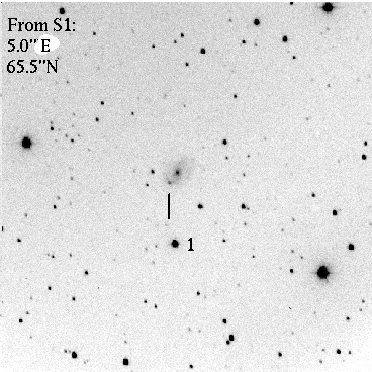

Circular No. 7929
Central Bureau for Astronomical Telegrams INTERNATIONAL ASTRONOMICAL UNION Mailstop 18, Smithsonian Astrophysical Observatory, Cambridge, MA 02138, U.S.A. IAUSUBS@CFA.HARVARD.EDU or FAX 617-495-7231 (subscriptions) BMARSDEN@CFA.HARVARD.EDU or DGREEN@CFA.HARVARD.EDU (science) URL http://cfa-www.harvard.edu/iau/cbat.html Phone 617-495-7244/7440/7444 (for emergency use only)
SUPERNOVA 2002dt IN ESO 516-G5
D. Hutchings and W. D. Li, University of California, report the discovery by LOTOSS (cf. IAUC 7906) of an apparent supernova (mag about 18.5) on unfiltered KAIT images taken on June 26.3 and 27.3 UT. SN 2002dt is located at R.A. = 16h03m47s.30, Decl. = -22o44'19".5 (equinox 2000.0), which is 7".8 east and 11".1 south of the nucleus of ESO 516-G5. A KAIT image taken on June 17.3 showed nothing at this position (limiting mag about 19.5). Li, R. Chornock, and A. V. Filippenko write that a spectrum of SN 2002dt, taken by M. M. Phillips with the Baade 6.5-m telescope at Las Campanas on June 28.0 UT, shows it to be clearly a supernova, but the exact type is uncertain. They add: "There are no hydrogen Balmer lines or the Si II 635.5-nm line that are typical of normal type-II and type-Ia supernovae, respectively. There are no Ca II H and K or infrared triplet lines that are typical of normal type- Ib/c supernovae. Narrow emission lines in the host galaxy yields a recession velocity of 7487 km/s. Converting to rest wavelengths, broad emission lines can be seen at 430, 503, and 560 nm. There are also dips around 580 and 700 nm. Based on the fact that the supernova is superposed on an H II region and lacks obvious type-Ia or type-II features, we suspect that this may be a core-collapse event related to the Ib/c variety (but possibly with substantial differences)."
-----------------------------
Host galaxy info: vel = 7487 km/s, 1.0 x 0.6, Sb
SN type info: Ib/c?
------------------------------
Return to KAIT home page